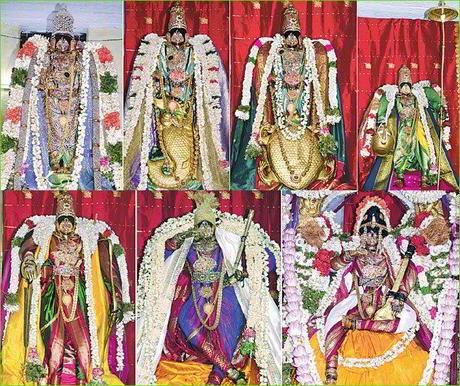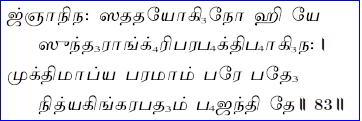- SlOkam 82:
- SlOkam 83:
- SlOkam 84:
suranaratiryagAdi bahubhedaka bhinnam idam
jagat atha ca aNDam aNDavaraNAni ca sapta tathA |
guNa purushau ca mukta purushA: ca vanAdripate:
upakaraNAni narma vidhaye api bhavanti vibho: ||
KUresar is struck with a sense of awe as he thinks about the upakaraNams (karuvikaL) for the Lord’s sport. All of these (DevAs, humans, birds, beasts, ever changing ones in the brahmANDam and those in the AvaraNams) are made up of tri guNams (prakrti), bhaddha jIvans bound by the triguNams and Mumukshu: (those who desire Moksham). What a wonder! All of these become the play things for the Lord of TirumAlirumcOlai.
Comments:
The sweep of coverage of the entities in brahmANDam by KUresar is breath taking:
“sura-nara-tiryak Adi bahu bhedaka bhinnam idam jagat, atha ca idam aNDam tathA sapta aNDAvaraNAni ca……..vanAdripate: narma vidhaye upakaraNAni bhavanti”.
jn~Anina: satata yogina: hi ye
sundarAnghri parabhaktibhAgina: |
muktimApya paramAm pare pade
nitya kinkarapadam bhajanti te ||
In the earlier Slokam, KUresar referred to mukta jIvans, who attained mukti by following karma-jn~Ana-bhakti-prapatti yogams. Here, KUresar celebrates these fortunate ones, who through their refuge at TirumAlirumcOlai Azhagar’s sacred feet at His lIlA vibhUti and reached His SrI VaikuNTha sthAnam (nitya vibhUti) and became eligible to perform kaimkaryams for Him there.
Meaning:
Those who always performed karma yogam (satata yogina:), the others who through their jn~Ana yogam recognized the antaryAmi brahmam inside their heart lotuses and yet others who practiced bhakti yogam or performed SaraNAgati at the sacred feet of the Lord of TirumAlirumcOlai (described in the 24th Slokam) attained mukti and became eligible for performing nitya kaimkaryam for the Lord at His Paramapadam (ye sundara anghri para bhakti bhAgina:, pare pade te paramAm muktim Apya nitya kinkara padam bhajanti). The importance of observing para bhakti is highlighted here.
devasya sundarabhujasya vanAdribhartu:
hai! SIlavattvam athavA ASritavatsalatvam |
aiSasvabhAvam ajahadbhi: iha avatArai:
ya: alancakAra jagat ASrita tulya dharmA ||
In this Slokam, KUresar provides an introduction to the theme of vibhava avatArams of the Lord, which he is going to cover next. The two divya guNams of sauSIlyam and ASrita vAtsalyam central to the vibhava avatArams are celebrated in the three Slokams starting from here.
Meaning:
Wonderful indeed are the two divyAtma guNams of VanAdrinAthan (Azhagar) that are clearly displayed without any impact on His svabhAvam (intrinsic nature) as the Lord of the Universe (ISvarana and devatA sArva-bhauman). These two guNams are sauSIlyam and Asrita vAtsalyam, which have been dominantly displayed during His many incarnations on this earth. Through that display, He practiced Asrita tulya dharmam (the dharmam of those, who sought His refuge) and SIlatvam (sauSIlyam). He hid His own brahmANDa prabhAvam and sarveSvaratvam and approached the AsritALs and mingled with them on an equal footing. He does not abandon His aiSvarartvam in these avatArams but hides them so that the AsritALs are not afraid to approach Him during these incarnations.
Comments:
AzhvAr refers to these many avatArams as: “innnina yOniyumAi imaiyOr talaivan piRakka”. The reason for these avatArams as Matsyam, KUrmam, nrsimham, vAmanan, rAman and KrshNan are manifestations of His sauSIlya and Asrita vAtsalya guNams. He never leaves however His sarveSvaratvam in all these avatArams that He takes (svabhAvam ajahat SaSvat AkrAntaram Akrte: ).
Source:
Oppiliappan KOil Sri Varadachari SaThakOpan Swami












